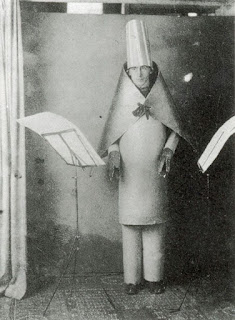The recent appointment of eminent Art historian Victoria Coates to
President Trump’s National Security Council, is a move that seems to have gone totally
under the radar. This is the body that advises the president over military
matters both at home and abroad and on the surface, looks like one of the more
left field appointments of what is already a seriously left field administration.
Really? An Art historian advising the Commander-in-Chief of the most powerful
military machine the world has ever seen?
But it may not be as random as it seems. Not only did she work
with Donald Rumsfeld in the late 2000s, but she recently advised Ted Cruz on
his foreign policy during the presidential campaign. But crucially, as an Art
historian, she is arguably better placed to understand the new politics of
‘fake news’ and ‘post-truth’ than most.
The Art world has been using the term ‘post-meaning’ for a
generation now, though its roots go further back to the beginning of Modern Art
itself. Briefly, it is a term used to describe Art works that may have multiple
readings which may not have been determined by the artist
at the time of creation, requiring human insight to unravel our own personal
understanding. It feels remarkably similar to ‘post-truth’, a concept that
allows the electorate to override facts and figures in preference for emotional
response and gut reaction.
 |
| Hugo Ball performing at Cabaret Voltaire in 1916 |
We see ‘post-meaning’ take shape with the Dada movement which emerged at the Cabaret Voltaire in Zurich in 1916. The works lay in bizarre performances of nonsensical poetry and
proto-abstract painting and sculpture, taking an absurdist and irrational stance
to counterpoise the horrific reality of the First World War. It was as if the Dadaists
were ignoring the appalling events going on around them, not as a denial of
reality but an insouciance to it. Their gallows humour is where ‘post-meaning’
takes root, out of a blasé reaction to the horrors of Man’s inhumanity to Man.
It was as if the facts didn’t really matter anymore. Life had lost its point,
its meaning, and all there was left to do was laugh at it.
In 1917, the French Artist Marcel Duchamp, a founding member of
Dada, turned a white porcelain urinal 90 degrees onto its back, titled it Fountain, signed it with the pseudonym R. Mutt, and presented it at the Society
of Independent Artists in New York. The organisers were so enraged that they
only agreed to exhibit the work behind a curtain, whereupon Duchamp’s friend
and patron Walter Arensberg bought it unseen, handing over a blank cheque for
the Artist to fill in.
 |
| Marcel Duchamp, Fountain, ceramic, 1916 |
Fountain crystallizes
what we understand to be ‘post-meaning’. There are multiple ways to try and
understand it but what is certain is that his usage of a public toilet is
clearly meant to cock a rude snook at the Establishment, and by claiming he had
transformed such a vulgar object into a rarefied work of Art, was to confront
the autonomous elite head-on. Not only did he challenge their position as
arbiters of what is and what isn’t Art, he went further and challenged their
right to decide what we should and shouldn’t think. The ramifications of this
extraordinary Art work are still being felt today, almost 100 years later, not
just in the Art world but in wider society as well.
We see a similar reaction in the aftermath of the Second World
War. Artists took to abstraction as a way to obfuscate the horrors of Nazi
atrocities, again not in denial but a blurring of them.
Fluxus, a group of Artists that emerged in the late 1950s, took
this further. Focusing on Performance Art as their preferred medium, they took
up the absurdist mantle of their Dadaist forebears, resulting in a strange
concoction of nonsense fused with reality. Classically-trained Charlotte
Moorman played her bow with her cello, Nam Jun Paik built sculptures out of TV
sets sputtering out white noise, whilst Yoko Ono offered us a pair of scissors to
cut her clothes off.
Fluxus painted a picture of the world that was upside down, inside out, back to front. It showed us things that we knew to be false, but in a context that we knew to be true, and ‘post-meaning’ was the only way to understand it. It helped the audience apply ‘meaning’ to a situation that didn’t necessarily have one.
 |
| Yoko Ono, A Cut Piece, performance, 1964 (re-created in 2003) |
Fluxus painted a picture of the world that was upside down, inside out, back to front. It showed us things that we knew to be false, but in a context that we knew to be true, and ‘post-meaning’ was the only way to understand it. It helped the audience apply ‘meaning’ to a situation that didn’t necessarily have one.
Last year, 52% of the UK and 46% of America had their Duchampian
moment and voted against the perceived consensus of their political elites. But
the awful dichotomy is that in the Art world, ‘post-meaning’ is a force for
sensory liberation and artistic exploration; whereas in the real world,
‘post-truth’ is a force for gross ignorance, divisive beliefs and potential
worldwide conflict. The problem is that life and Art are too very different
things, and whilst its fine for Art to imitate life, it’s very dangerous when
it’s the other way around.
Comments
Post a Comment